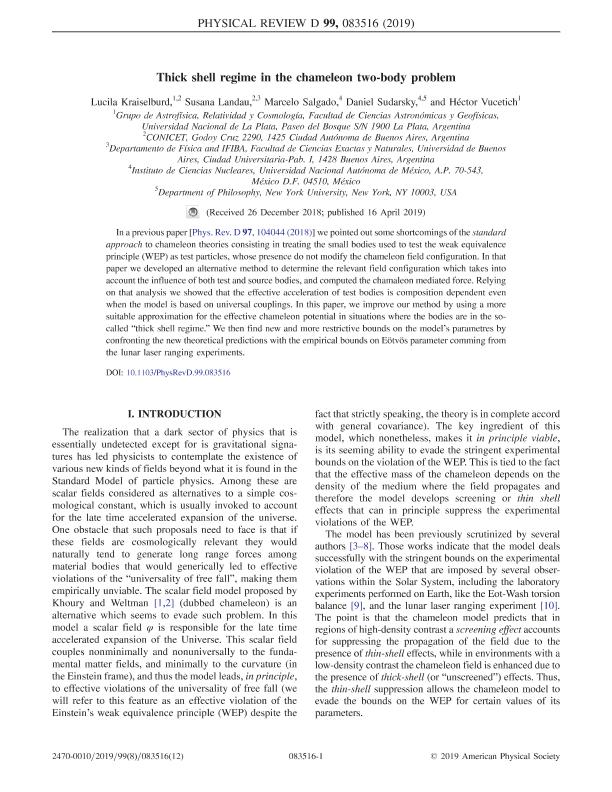Mostrar el registro sencillo del ítem
dc.contributor.author
Kraiselburd, Lucila

dc.contributor.author
Landau, Susana Judith

dc.contributor.author
Salgado, Marcelo

dc.contributor.author
Sudarsky, Daniel
dc.contributor.author
Vucetich, Hector

dc.date.available
2020-11-30T13:33:29Z
dc.date.issued
2019-05
dc.identifier.citation
Kraiselburd, Lucila; Landau, Susana Judith; Salgado, Marcelo; Sudarsky, Daniel; Vucetich, Hector; Thick shell regime in the chameleon two-body problem; American Physical Society; Physical Review D; 99; 8; 5-2019; 1-12
dc.identifier.issn
1550-7998
dc.identifier.uri
http://hdl.handle.net/11336/119325
dc.description.abstract
In a previous paper [Phys. Rev. D 97, 104044 (2018)] we pointed out some shortcomings of the standard approach to chameleon theories consisting in treating the small bodies used to test the weak equivalence principle (WEP) as test particles, whose presence do not modify the chameleon field configuration. In that paper we developed an alternative method to determine the relevant field configuration which takes into account the influence of both test and source bodies, and computed the chamaleon mediated force. Relying on that analysis we showed that the effective acceleration of test bodies is composition dependent even when the model is based on universal couplings. In this paper, we improve our method by using a more suitable approximation for the effective chameleon potential in situations where the bodies are in the socalled “thick shell regime.” We then find new and more restrictive bounds on the model’s parametres by confronting the new theoretical predictions with the empirical bounds on Eötvös parameter comming from the lunar laser ranging experiments.
dc.format
application/pdf
dc.language.iso
eng
dc.publisher
American Physical Society

dc.rights
info:eu-repo/semantics/openAccess
dc.rights.uri
https://creativecommons.org/licenses/by-nc-sa/2.5/ar/
dc.subject
TEORÍAS ALTERNATIVAS DE GRAVEDAD
dc.subject
LUNAR LASER RANGING
dc.subject.classification
Astronomía

dc.subject.classification
Ciencias Físicas

dc.subject.classification
CIENCIAS NATURALES Y EXACTAS

dc.title
Thick shell regime in the chameleon two-body problem
dc.type
info:eu-repo/semantics/article
dc.type
info:ar-repo/semantics/artículo
dc.type
info:eu-repo/semantics/publishedVersion
dc.date.updated
2020-11-19T15:50:05Z
dc.identifier.eissn
2470-0029
dc.journal.volume
99
dc.journal.number
8
dc.journal.pagination
1-12
dc.journal.pais
Estados Unidos

dc.description.fil
Fil: Kraiselburd, Lucila. Universidad Nacional de La Plata. Facultad de Ciencias Astronómicas y Geofísicas; Argentina. Consejo Nacional de Investigaciones Científicas y Técnicas. Centro Científico Tecnológico Conicet - La Plata; Argentina
dc.description.fil
Fil: Landau, Susana Judith. Consejo Nacional de Investigaciones Científicas y Técnicas. Oficina de Coordinación Administrativa Ciudad Universitaria. Instituto de Física de Buenos Aires. Universidad de Buenos Aires. Facultad de Ciencias Exactas y Naturales. Instituto de Física de Buenos Aires; Argentina
dc.description.fil
Fil: Salgado, Marcelo. Universidad Nacional Autónoma de México. Instituto de Ciencias Nucleares; México
dc.description.fil
Fil: Sudarsky, Daniel. Universidad Nacional Autónoma de México. Instituto de Ciencias Nucleares; México
dc.description.fil
Fil: Vucetich, Hector. Universidad Nacional de La Plata. Facultad de Ciencias Astronómicas y Geofísicas; Argentina. Consejo Nacional de Investigaciones Científicas y Técnicas. Centro Científico Tecnológico Conicet - La Plata; Argentina
dc.journal.title
Physical Review D

dc.relation.alternativeid
info:eu-repo/semantics/altIdentifier/url/https://journals.aps.org/prd/abstract/10.1103/PhysRevD.99.083516
dc.relation.alternativeid
info:eu-repo/semantics/altIdentifier/doi/http://dx.doi.org/10.1103/PhysRevD.99.083516
Archivos asociados
